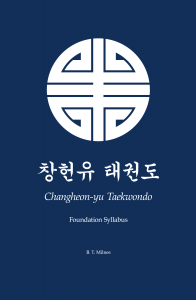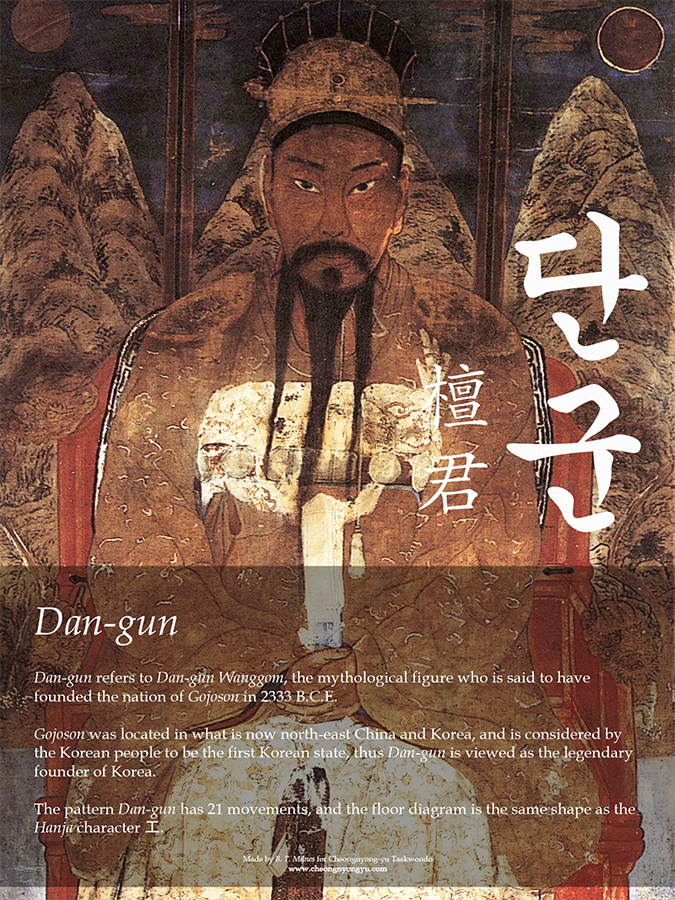단군
← Previous Form: Chonji – Next Form: Dosan →
Revised Romanisation: Dan-gun
McCune-Reischauer Romanisation: Tan-gun
Sometimes written: Dan Gun, Tan Gun
Floor Diagram for Dan-gun

Movements of Dan-gun
There are 21 movements in Dan-gun.
Form a parallel ready stance towards A.
- Turn to the left and step towards E with the left foot, forming a right ‘l’ stance towards E. Perform a guarding block to the mid section with the knife-hand.
- Step towards E with the right foot, forming a right walking stance towards E. Punch to the high section with the right fore-fist.
- Turn to the right and step towards C with the right foot, forming a left ‘l’ stance towards C. Perform a guarding block to the mid section with the knife-hand.
- Step towards C with the left foot, forming a left walking stance towards C. Punch to the high section with the left fore-fist.
- Turn to the left and step towards A with the left foot, forming a left walking stance towards A. Block to the low section with the left outer-forearm.
- Step towards A with the right foot, forming a right walking stance towards A. Punch to the high section with the right fore-fist.
- Step towards A with the left foot, forming a left walking stance towards A. Punch to the high section with the left fore-fist.
- Step towards A with the right foot, forming a right walking stance towards A. Punch to the high section with the right fore-fist.
- Turn to the left and step towards B with the left foot, forming a right ‘l’ stance towards B. Perform a twin forearm block.
- Step towards B with the right foot, forming a right walking stance towards B. Punch to the high section with the right fore-fist.
- Turn to the right and step towards F with the right foot, forming a left ‘l’ stance towards F. Perform a twin forearm block.
- Step towards F with the left foot, forming a left walking stance towards F. Punch to the high section with the left fore-fist.
- Turn to the left and step towards D with the left foot, forming a left walking stance towards D. Block to the low section with the left outer-forearm.
- Without changing stance, perform a rising block to the high section with the left outer-forearm. Perform movements 13 and 14 in quick succession.
- Step towards D with the right foot, forming a right walking stance towards D. Perform a rising block to the high section with the right outer-forearm.
- Step towards D with the left foot, forming a left walking stance towards D. Perform a rising block to the high section with the left outer-forearm.
- Step towards D with the right foot, forming a right walking stance towards D. Perform a rising block to the high section with the right outer-forearm.
- Turn to the left and step towards E with the left foot, forming a right ‘l’ stance towards E. Strike to the neck with the left knife-hand.
- Step towards E with the right foot, forming a right walking stance towards E. Punch to the high section with the right fore-fist.
- Turn to the right and step towards C with the right foot, forming a left ‘l’ stance towards C. Strike to the neck with the right knife-hand.
- Step towards C with the left foot, forming a left walking stance towards C. Punch to the high section with the left fore-fist.
Turn to the left, moving the left foot to the right foot, and form a parallel ready stance towards A.
Learning Dan-gun
- All of the punches in this form are to the high section.
- The form is symmetric – movements performed to the left of the central line are also performed to the right.
Korean terminology relevant to Dan-gun
| English | Korean |
| knife-hand | 손칼 sonkal |
| guarding block | 대비 막기 daebi makki |
| low section | 나즌데 najunde |
| mid section | 가운데 kaunde |
| high section | 높은데 nopunde |
| twin forearm block | 쌍 팔목 막기 ssang palmok makki |
| rising block | 추켜 막기 chukyo makki |
| strike | 때리기 ttaerigi |
| knife-hand strike | 손칼 때리기 sonkal ttaerigi |
More information

You can find more information on this topic in the book Changheon-yu Taekwondo: Foundation Syllabus, which is a handbook for colour belt students who are training in Changheon-yu Taekwondo (ITF Taekwondo). It contains movement descriptions, floor diagrams, and relevant Korean terminology for all of the colour belt patterns.
Why not buy a Dan-gun poster?

Make learning the meanings of the patterns more fun with this poster about the historical figure of Dan-gun.
If you're a Taekwondo instructor, this would be an excellent poster to put up on the wall of your dojang to help students learn the meaning of the patterns. Or you could just put it on your wall at home!
